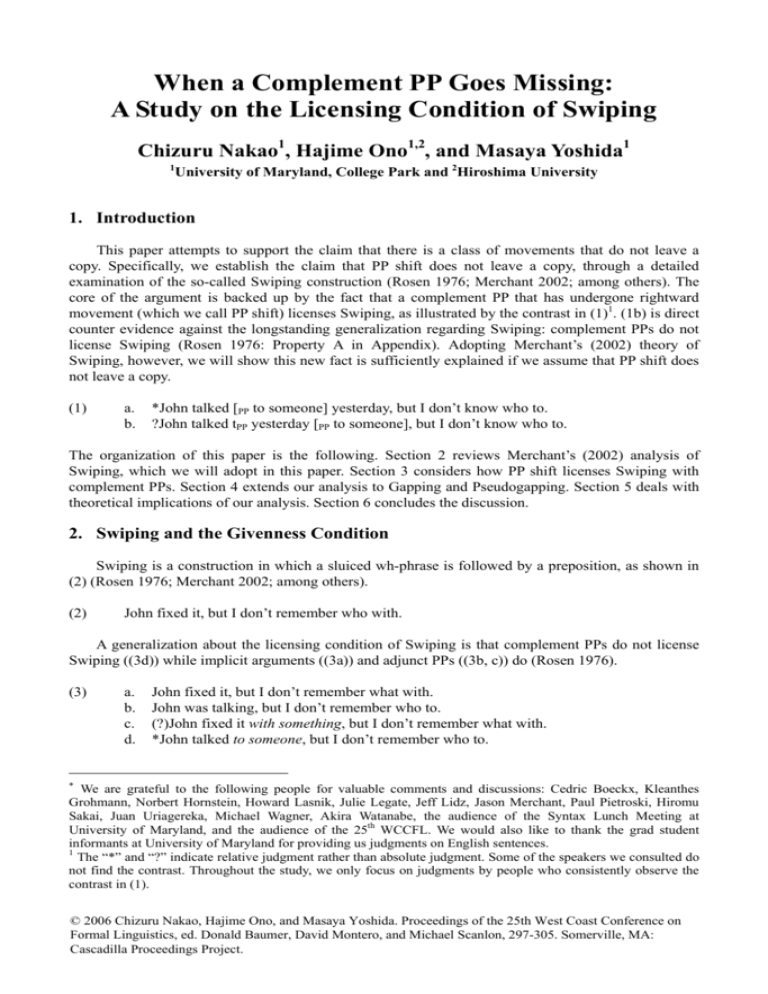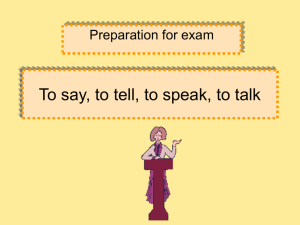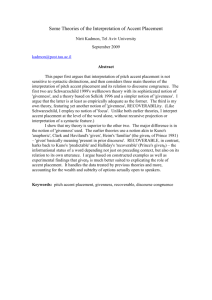
When a Complement PP Goes Missing:
A Study on the Licensing Condition of Swiping
Chizuru Nakao1, Hajime Ono1,2, and Masaya Yoshida1
1
University of Maryland, College Park and 2Hiroshima University
1. Introduction
This paper attempts to support the claim that there is a class of movements that do not leave a
copy. Specifically, we establish the claim that PP shift does not leave a copy, through a detailed
examination of the so-called Swiping construction (Rosen 1976; Merchant 2002; among others). The
core of the argument is backed up by the fact that a complement PP that has undergone rightward
movement (which we call PP shift) licenses Swiping, as illustrated by the contrast in (1)1. (1b) is direct
counter evidence against the longstanding generalization regarding Swiping: complement PPs do not
license Swiping (Rosen 1976: Property A in Appendix). Adopting Merchant’s (2002) theory of
Swiping, however, we will show this new fact is sufficiently explained if we assume that PP shift does
not leave a copy.
(1)
a.
b.
*John talked [PP to someone] yesterday, but I don’t know who to.
?John talked tPP yesterday [PP to someone], but I don’t know who to.
The organization of this paper is the following. Section 2 reviews Merchant’s (2002) analysis of
Swiping, which we will adopt in this paper. Section 3 considers how PP shift licenses Swiping with
complement PPs. Section 4 extends our analysis to Gapping and Pseudogapping. Section 5 deals with
theoretical implications of our analysis. Section 6 concludes the discussion.
2. Swiping and the Givenness Condition
Swiping is a construction in which a sluiced wh-phrase is followed by a preposition, as shown in
(2) (Rosen 1976; Merchant 2002; among others).
(2)
John fixed it, but I don’t remember who with.
A generalization about the licensing condition of Swiping is that complement PPs do not license
Swiping ((3d)) while implicit arguments ((3a)) and adjunct PPs ((3b, c)) do (Rosen 1976).
(3)
a.
b.
c.
d.
John fixed it, but I don’t remember what with.
John was talking, but I don’t remember who to.
(?)John fixed it with something, but I don’t remember what with.
*John talked to someone, but I don’t remember who to.
∗
We are grateful to the following people for valuable comments and discussions: Cedric Boeckx, Kleanthes
Grohmann, Norbert Hornstein, Howard Lasnik, Julie Legate, Jeff Lidz, Jason Merchant, Paul Pietroski, Hiromu
Sakai, Juan Uriagereka, Michael Wagner, Akira Watanabe, the audience of the Syntax Lunch Meeting at
University of Maryland, and the audience of the 25th WCCFL. We would also like to thank the grad student
informants at University of Maryland for providing us judgments on English sentences.
1
The “*” and “?” indicate relative judgment rather than absolute judgment. Some of the speakers we consulted do
not find the contrast. Throughout the study, we only focus on judgments by people who consistently observe the
contrast in (1).
© 2006 Chizuru Nakao, Hajime Ono, and Masaya Yoshida. Proceedings of the 25th West Coast Conference on
Formal Linguistics, ed. Donald Baumer, David Montero, and Michael Scanlon, 297-305. Somerville, MA:
Cascadilla Proceedings Project.
298
Merchant (2002) gives the following account of this asymmetry: Swiping is licensed only if the PP is
not “given” in the antecedent of the elided IP. (Merchant (2001) assumes that Sluicing involves
IP-ellipsis.) He observes that a Swiped preposition is always focused (which is indicated by prosodic
stress: Property C in Appendix). If it is “given”, it violates the Givenness Condition in (4)2.
(4)
The Givenness Condition: The content of the focused P should not be given.
The Givenness Condition correctly excludes (3d) while it includes (3a) and (3b). (3d) violates the
Givenness Condition because the complement PP is present in the antecedent clause and hence it is
“given”. (3a) and (3b) satisfy it because the Swiped PP is not present in the antecedent clause and
hence it is not “given” in the antecedent clause.
(3c) is apparently problematic; the presence of the overt adjunct PP in the antecedent clause seems
to violate the Givenness Condition. However, Merchant claims that it is not “given” in the lowest VP
segment because it is adjoined to VP, as illustrated in (5).
(5)
John [VP [VP tJohn fixed it] with something], but I don’t remember [CP [PP what with] [IP John
fixed it [PP with what]].
Merchant’s (2001) theory of ellipsis defines the semantic isomorphism between an elided constituent
and its antecedent in terms of a mutual entailment requirement. In this system, the lowest VP segment
in (5) is a potential antecedent for the elided IP, because the VP segment, which contains the trace/copy
of the subject (VP-internal Subject Hypothesis by Fukui and Speas 1986; Kitagawa 1986; Kuroda
1988; Koopman and Sportiche 1991), is in a mutual entailment relation with the elided IP3. As the
adjunct PP with something is excluded from the antecedent of IP-deletion, (5) satisfies the Givenness
Condition. To recapitulate, a Swiped PP must not be “given” in the antecedent of the elided IP.
3. PP shift and Swiping
3.1. A problem for the previous generalization and its account
Under the Givenness Condition, complement PPs cannot license Swiping as seen in (3d). Thus,
(1b), where a complement PP licenses Swiping, is an apparent counterexample against this account. In
this section, however, we will show that the data in (1) are still compatible with the Givenness
Condition; we propose that PP shift in (1b) makes a complement PP “not given”.
The intuition behind our claim is that PP shift puts the PP outside the VP, and therefore makes it
“not given” inside the lowest VP segment, as illustrated in (6). (6) is similar to the representation in (5)
in that the PP is not present in the antecedent of the elided IP and the Givenness Condition is satisfied.
(6)
[IP John [VP tJohn talked PP_ ] yesterday] [PP to someone], but I don't know [CP who+to [IPJohn
[VP talked [PP to who]]].
To support this intuition, we propose that PP shift does not leave a copy. If there is no copy, the claim
that the PP in (6) is “not given” naturally follows because the PP does not exist inside the antecedent at
LF; if there is a copy, on the other hand, the copy would be still “given” inside the VP segment, as
shown in (7).
(7)
2
[IP John [VP tJohn talked [PP to someone]] yesterday] [PP to someone], but I don’t know
[CP who+to [IP John [VP talked [PP to who]]].
Merchant calls this condition “AvoidF,” following the insight of Schwarzchild (1999). Throughout this paper,
however, we will use the term “the Givenness Condition” to exclusively refer to the Merchant’s definition of this
condition, which slightly differs from Schwarzchild’s original definition.
3
See Merchant (2001) and Yoshida (2006) for more discussion. See also, Hornstein (1994) for a similar
argument on Antecedent Contained Deletion.
299
In short, the data in (1) are compatible with the Givenness Condition if PP shift does not leave a copy.
3.2. PP runs away from home: Argument for PP shift as a copy-free operation
There are two pieces of independent evidence to show that PP shift does not leave a copy. The first
piece of evidence comes from the lack of reconstruction effects in variable-binding shown in (8)4.
(8)
a.
b.
[IP Someone [VP gave every book1 [PP to its1 prize winning author]] yesterday].
(some>every, every>some)
[IP [IP Someone [VP gave every book1 tPP] yesterday] [PP to its1 prize winning author]].
(??some>every, every>some)
In (8a), every can take either the wide or the narrow scope with respect to someone to bind the variable
inside the PP. If this PP undergoes PP shift as in (8b), on the other hand, every must scope over
someone to obtain the bound reading of the pronoun inside the PP5. Differently put, every must be in a
higher position than some at LF if the pronoun is to be bound by it. This asymmetry suggests that the
PP in (8b) cannot be interpreted in its original position, hence no reconstruction takes place. This in
turn suggests the absence of the copy left by PP shift.
The second piece of evidence is that PP shift does not block contraction (Lasnik 1984). Copulas in
English can be contracted as in (9b, c). The contraction is blocked, however, by intervening wh-traces
((9e, f)).
(9)
a.
b.
c.
d.
e.
f.
John is in the room now.
John’s in the room.
John’s tPP now [PP in the room].
I don’t know where1 John is t1.
*I don’t know where1 John’s t1.
*I don’t know where1 John’s t1 now.
The data show that the clitic ‘s must be dependent on a morphologically realized category on its right
(Bresnan 1971; Boeckx 2000; among others). While a wh-trace somehow blocks contraction as in (9e,
f), it is not blocked by a trace of PP shift as shown in (9c). This is naturally accounted for under the
assumption that PP shift does not leave a copy.6
Related to the point above, there is another contrast between wh-movement and PP shift:
wh-movement does not license Swiping as in (10), while PP shift does (as we observed in (1b)).
(10)
*I wonder [PP to whom] John talked [PP to whom], but you know who to.
Recall that PP shift makes a PP “not given” because it does not leave a copy. Given that wh-movement
leaves a copy under standard assumptions (Chomsky 1993, 1995, and subsequent works), we predict
that wh-movement should not license Swiping. (10) confirms this prediction, and thus supports our
claim that PP shift does not leave a copy while wh-movement does.
3.3. On the complementhood of the shifted PP
4
We owe this example to Jeff Lidz (p.c.).
This piece of data supports the claim by Hornstein (1995) and Johnson and Tomioka (1998) that a subject
quantifier undergoes lowering rather than raising when it takes a narrow scope than an object. The LF
representation in (i), where every scopes over someone and still c-commands the shifted PP, must be excluded.
5
(i)
[IP someone2 [IP every book1 [IP [IP t2 [VP gave t1 tPP] yesterday] [PP to its1 prize winning author]]]]
6
This paradigm points in the same direction as the analysis of wanna contraction by Boeckx (2000) and Hornstein
(2001).
300
Finally, let us consider one potential counter-argument against our position. One might argue that
the PP in (1) is an adjunct rather than a complement, and hence, (1b) is not problematic for the
Givenness Condition in the first place. However, we can point out various constituency tests that
demonstrate that the PP in (1) is indeed a complement.
First, the VP constituency tests such as do-so substitution (Lakoff and Ross 1976) show that do-so
cannot take the verb talk excluding the PP in (11b), in contrast with the case of a typical adjunct PP in
(11d). This suggests that the PP is the sister of the verb talk.
(11)
a.
b.
c.
d.
John talked [PP to Mary]. Bill did so, too.
*?John talked [PP to Mary]. Bill did so [PP to Susan].
John talked [PP in the room]. Bill did so, too.
John talked [PP in the room]. Bill did so [PP in the hallway].
Second, VP fronting cannot strand the PP as in (12b), while the adjunct PP can be stranded in
(12d).
(12)
a.
b.
c.
d.
Talk [PP to Mary], John did _.
*Talk, John did _ [PP to Mary].
Talk [PP in the room], John did _.
Talk, John did _ [PP in the room].
Third, the interpretation of the fronting of the PP is more restricted than that of adjunct PPs. When
the PP in (13a) is fronted, only the topicalization interpretation is allowed. On the other hand, the
fronted PP in (13b) does not necessarily induce the topicalization interpretation.
(13)
a.
b.
c.
?To Mary, John talked.
?Mary, John likes.
In the room, John talked.
Finally, the extraction of the PP in (14a) shows relative tolerance to wh-island violation compared
to the adjunct PP in (14b); it behaves more like a complement wh-phrase in (15a) (Huang 1982).
(14)
(15)
a.
b.
a.
b.
??[To whom]1 did John wonder whether Bill talked t1?
*[With whom]1 did John wonder whether Bill danced t1?
?What1 did John wonder whether Bill fixed t1?
*How1 did John wonder whether Bill fixed the car t1?
Taken together, these facts indicate that the shifted PP in (1) is a complement PP.
4. Extensions: Gapping and Pseudogapping
In this section, we will extend our discussion in the previous section to two other constructions:
Gapping and Pseudogapping. Much like PP shift ((1b)), a complement PP left by Gapping or
Pseudogapping licenses Swiping, as shown in (16b, c). This pattern suggests that the PPs in these
examples have the same status as the one in PP shift constructions.
(16)
a.
b.
c.
*John talked to Mary, and Bill talked to someone else. I don’t remember who to.
?John talked to Mary, and Bill talked to someone else. I don’t remember who to.
?John talked to Mary, and Bill did to someone else. I don’t remember who to.
The Gapping data in (16b) naturally falls under our analysis if we adopt the “movement and
deletion” type of approaches to Gapping (Jayaseelan 1990; Lasnik and Saito 1991; Yoshida 2005,
2006: cf. Johnson 1994; Lin 2000). Under the analysis, the complement PP undergoes rightward
movement under Gapping, as in (17) (the landing site of this movement varies depending on the
301
analysis).
(17)
Mary talked to Bill and Susan [IP/VP [VP talked t1] [PP to Harry]1].
Under this approach, the rightward movement (PP shift in our terms) of the PP to Harry does not leave
a copy and it becomes “not given” inside the VP. Since the Givenness Condition is satisfied, it is
predicted that a PP left by Gapping licenses Swiping.
Similarly, the Pseudogapping example in (16c) is explained if we grant that A-movement does not
leave a copy, as claimed by Chomsky (1995), Lasnik (1998, 1999a), and Fox (1999)7, 8. Lasnik (1999b)
argues that Pseudogapping remnants undergo A-movement to [Spec, Agro].
(18)
Mary hasn’t talked to Bill, but she has [AgroP [PP to Harry]1 Agro [VP talked t1]].
If A-movement does not leave a copy, the remnant PP is “not given” inside the VP and the Givenness
Condition is satisfied in (16c) as well.
In sum, the “movement-and-deletion” type of approach to Gapping and Pseudogapping can
accommodate the new data, when combined with the claim that PP shift, as well as A-movement, does
not leave a copy. Any analysis of Gapping or Pseudogapping that does not assume copy-free
movement of the remnant would have difficulty accounting for the contrast in (16).
Finally, Pseudogapping provides additional support for our analysis. Lasnik (1999b) observes that
Pseudogapping allows P-stranding ((19a)) in the same way as A-movement such as Passive does
((19b))9.
(19)
a.
b.
John talked about something and Bill did someone.
John1 was talked about t1 by everyone.
Under the “givenness” analysis, if a preposition is stranded and stays in its original position, the
content of P is still “given” in the lowest VP-segment (Merchant 2002; p.c.). Thus, we predict that
P-stranded Pseudogapping does not license Swiping. This prediction is borne out in (20a).
(20)
a.
b.
*John talked about something and Bill did someone. I don’t remember who about.
?John talked about something and Bill did about someone. I don’t remember who about.
In this section, we have shown that Gapping/Pseudogapping remnants license Swiping, which
indicates that those constructions involve copy-free movements (i.e. PP shift for Gapping and
7
Lasnik (1998) claims that A-movement does not leave a copy by demonstrating several configurations where
scope reconstruction is impossible with A-movement (e.g. (i)).
(i)
Every coin is 3% likely to land heads. (every>likely, *likely>every)
He claims that the apparent “Quantifier Lowering” effect in (ii) (May 1977) is due to the special property of
indefinite subjects. (See Hornstein 2001, 2003; Boeckx 2001; Nevins and Anand 2003; among others, for
alternative views of A-movement.)
(ii) Some politician is likely to address John’s constituency. (some>likely, likely>some)
8
However, the analysis of (6) we employ makes a crucial use of the VP-internal subject trace. We leave open the
exact status of subject raising to [IP, Spec] here, and use the term “A-movement” to refer to the Object Shift type
movement in (18).
9
On the other hand, Gapping does not allow P-stranding ((ia)), which parallels with Heavy NP Shift ((ib)). This
contrast between Gapping and Pseudogapping, among other evidence, leads to Lasnik’s (1999b) conclusion that
Pseudogapping involves A-movement rather than rightward movement.
(i)
a.
b.
*John talked about something and Bill someone.
*John talked about t1 yesterday [someone from our department]1.
302
A-movement for Pseudogapping).
5. Theoretical considerations
5.1. On the nature of PP shift
Our data in this paper have some implications for the nature of PP shift. First, the unacceptability
of (1a) shows that there should be no derivation where covert PP shift makes the Swiping possible.
(1)
a.
*[IP John [VP tJohn talked [PP to someone]] yesterday], but I don't remember who to.
This indicates either that covert PP shift is impossible or that covert PP shift does not feed Swiping.
Additionally, recall that the complement PP in (3a) (where there is no element to indicate
clause-boundary) cannot license Swiping; it cannot become “not given” by string-vacuous PP shift.
(3)
a.
*John talked [PP to someone], but I don’t know who to.
Again, this indicates either that there is no string-vacuous PP shift, or that string-vacuous PP shift does
not affect Swiping. We would like to investigate these possibilities in future research.
Furthermore, the acceptability of (1b) shows that PP shift cannot be PF-movement. We argued that
the PP in (1b) is “not given” because PP shift does not leave a copy. This implies that shifted PP is not
present in the LF-component, where presumably “givenness” is calculated. If PP shift is PF-movement,
the PP in (1b) would remain in-situ at LF and the Givenness Condition would be violated.
5.2.
The Copy Theory of Movement and Copy-Free Movement
Our analysis of Swiping raises a problem with the current standard of the Copy Theory of
Movement (Chomsky 1993, 1995, among many others). Under the Copy Theory of Movement,
movement is a complex operation of Copy and Merge, and it is difficult to accommodate the notion of
movement that does not leave a copy.
In order to deal with this problem, we would like to point out three possibilities to explore. First,
we could say that “movement that does not leave a copy” leaves a simple trace instead of a copy. Fox
(1999) claims that A-movement (optionally) leaves a simple trace. Second, we could assume that
“movement that does not leave a copy” involves some kind of copy deletion in addition to Copy plus
Merge. Third, we could admit that A-movement and PP shift also leave a copy, but a copy left by such
movement is not used for calculation of “givenness” and reconstruction. We would like to explore in
future research ways to tease these possibilities apart.
Alternatively, one might argue that shifted PPs and A-moved DPs are base-generated in the
surface position, rather than moved without a copy. However, the data show that PP shift and
A-movement make a complement an island, as shown in (21) and (22). The PP in (21b) undergoes PP
shift. The DP in (22b) undergoes Object Shift past the verb particle, under Johnson’s (1991) analysis.
(21)
(22)
a.
b.
a.
b.
Who1 did you talk [PP to t1] yesterday?
*Who1 did you talk tPP yesterday [PP to t1]?
Who1 did you call up [DP a friend of t1]?
*Who1 did you call [DP a friend of t1] up tDP?
(Lasnik 2001)
We assume these are instances of derived position islands ((23): Wexler and Culicover 1980; Takahashi
1994; Merchant 2001).
(23)
Derived position island: Wh-movement out of a moved element is not allowed.
If the PP in (21b) and the DP in (22b) are base-generated, their islandhood remains mysterious. This
suggests that the base-generation approach to A-movement and PP shift is inappropriate.
303
6. Conclusion
This paper argued that there is a class of movements that does not leave a copy (e.g. PP shift and
A-movement). Data from Swiping demonstrated that a complement PP that undergoes PP shift
becomes “not given”. Our study on PP shift raises an important question for the Copy Theory of
Movement. We have indicated several potential solutions to the question, but the problems are left
open for future research.
Appendix: On the analysis of Swiping
So far, we simply assumed Merchant’s (2002) “givenness” account of Swiping. In this appendix,
we argue for his analysis of Swiping in contrast to an alternative analysis by van Craenenbroeck
(2004).
There are three properties of Swiping that any analysis of Swiping has to account for. First,
complement PPs do not license Swiping as already shown in (3) (Property A). Second, only simple
wh-phrases (e.g. who) in contrast to complex wh-phrases (e.g. which person) as shown in (24)
(Property B).
(24)
a.
b.
John was talking but I don’t know who to.
*John was talking but I don’t know which person to.
Third, a Swiped preposition must bear stress (Property C).
(25)
John was talking, but I don’t know {*WHO to/who TO}.
Merchant (2002) explains all three properties in the following way. First, the Givenness Condition
(4) accounts for Property A as discussed in Section 2. Second, he analyzes Swiping as an instance of
head-movement as illustrated in (26a), which derives the word order in (26b). Under the assumption
that only monomorphemic wh-phrases are heads, Property B naturally derives as head-movement is
only applicable for heads.
(26)
a.
b.
[PP P D] -> [PP D+P tD],
where wh-phrase = D0
[CP [PP who+to] [IP John talked [PP to who]]]
Third, he attributes Property C to a prosodic condition of English: the prosodic pattern in Swiping must
be head-final. Head-final also accounts for why the wh-phrase bears stress in Sluicing.
(27)
John talked to someone, but I don’t know WHO.
Van Craenenbroeck (2004) gives an alternative account for Swiping that does not employ the
Givenness Condition. He assumes the double-CP structure in (28), where the preposition about is
stranded in the intermediate [Spec, CP2].
(28)
I don’t know [CP1 what [ C1 [CP2 [PP about what] [ C2 [IP Ed wrote a book [PP about what]]
If this analysis is on the right track, our account, which crucially relies on the Givenness Condition,
will be undermined.10
Van Craenenbroeck’s account, however, has several drawbacks. Although he accounts for Property
10
One advantage of this analysis over Merchant’s (2002) is that it can accommodate examples such as (i).
(i)
John was dancing. Who do you think with?
If Swiping is always derived by head-movement as in (26), this word-order is unexpected.
304
C by saying that [Spec, CP2] is a focus position and must bear stress, his analysis cannot give
satisfactory explanations for Property A and B. For Property A, he claims that the existence of an
antecedent blocks Swiping because the focus position ([Spec, CP2] in (28)) must be “new
information.” This does not explain the adjunct-complement asymmetry in (3c-d). For Property B, he
argues that only simple wh-phrases undergo the derivation in (28) because complex wh-phrases are
base-generated in the topmost [Spec, CP1]. This is a mere stipulation and does not have concrete
supporting evidence.
Given these problems, we adopt Merchant’s analysis on Swiping, which employs the Givenness
Condition to account for Property A (complement PPs do not license Swiping).
References
Boeckx, Cedric. 2000. A note on contraction, Linguistic Inquiry 31: 357-365.
Boeckx, Cedric. 2001. Scope reconstruction and A-movement, Natural Language & Linguistic Theory 19:
503-548.
Bresnan, Joan. 1971. Contraction and the transformational cycle, ms., MIT, Cambridge, MA.
Chomaky, Noam. 1993. A minimalist program for linguistic theory, The view from the building 20: Essays in
linguistics in honor of Sylvain Bromberger, ed. by Ken Hale and Samuel J. Kayser, MIT Press, Cambridge,
MA: 1-52.
Chomsky, Noam. 1995. Minimalist Program, MIT Press, Cambridge, MA.
Craenenbroeck, Jeroen van. 2004. Ellipsis in Dutch Dialects, Ph.D. dissertation, Leiden University, Leiden.
Fox, Danny. 1999. Reconstruction, binding theory and the interpretation of chains, Linguistic Inquiry 30: 157-196.
Fukui, Naoki and Margaret Speas. 1986. Specifiers and projection, MIT working papers in linguistics 8: 128-172.
Hornsetin, Norbert. 1994. An argument for minimalism: The case of Antecedent-Contained Deletion, Linguistic
Inquiry 25: 455-480.
Hornstein, Norbert. 1995. Logical Form: From GB to Minimalism, Blackwell, Cambridge, MA.
Hornstein, Norbert. 2001. Move! A Minimalist Theory of Construal, Blackwell, Oxford.
Hornstein, Norbert. 2003. On Control, Minimalist Syntax, ed. by Randall Hendrick, Blackwell, Malden, MA: 6-81.
Huang, C.-T. James. 1982. Logical relations in Chinese and the theory of grammar, Ph.D. dissertation, MIT,
Cambridge, MA.
Jayaseelan, K. A. 1990. Incomplete VP Deletion and Gapping, Linguistic Analysis 20: 64-81.
Johnson, Kyle. 1991. Object positions, Natural Language and Linguistic Theory 9: 577-636.
Johnson, Kyle. 1994. Bridging the gap, ms., University of Massachusetts, Amherst.
Johnson, Kyle and Satoshi Tomioka. 1997. Lowering and mid-size clauses, Reconstruction: Proceedings of the
1997 Tübingen Workshop, ed. by Graham Katz, Shin-Sook Kim and Heike Winhart, Universität Stuttgart and
Universität Tübingen: 185-206.
Kitagawa, Yoshihisa. 1986. Subjects in Japanese and English, Ph.D. dissertation, University of Massachusetts,
Amherst.
Koopman, Hilda and Dominique Sportiche. 1991. The position of subjects, Lingua 85: 211-258.
Kuroda, Shige-Yuki. 1988. Whether we agree or not: A Comparative Syntax and English and Japanese,
Lingvisticae Investigationes 12: 1-47.
Lakoff, George and John R. Ross. 1976. Why you can’t do so into the sink, Notes from the linguistics
underground, vol.7 of Syntax and semantics, ed. by James McCawley, Academic Press, New York: 101-111.
Lasnik, Howard. 1984. Lecture 5: Further Properties of Empty Categories, a lecture at Tokyo Linguistics Seminar:
A series of lectures on current issues in the theories of syntax and logical form, August 1984, Tokyo.
Lasnik, Howard. 1998. Some Reconstruction Riddles, University of Pennsylvania Working Papers in Linguistics
5: 83-98.
Lasnik, Howard. 1999a. Chains of arguments, Working Minimalism, ed. by Samuel Epstein and Norbert Hornstein,
MIT Press, Cambridge, MA: 189-215.
Lasnik, Howard. 1999b. Pseudogapping Puzzles, Fragments: Studies in Ellipsis and Gapping ed. by Shalom
Lappin and Elabbas Benmamoun, Oxford University Press, Oxford: 141-174.
Lasnik, Howard. 2001. Subjects, Objects and EPP, Objects and Other Subjects: Grammatical Functions,
Functional Categories, and Configurationality, ed. by William D. Davies and Stanley Dubinsky, Kluwer
Academic Publishers, Dordrecht: 103-121.
305
Lasnik, Howard and Mamoru Saito. 1991. Curious correlations between configurations licensing (or failing to
license) Heavy NP Shift and those for Gapping, ms., University of Connnecticut, Storrs.
Lin, Vivian. 2000. Determiner Sharing, Proceedings of West Coast Conference on Formal Linguistics 19, ed. by
Roger Billerey and Brook D. Lillehaugen, Cascadilla Press, Somerville, MA: 274-287.
May, Robert. 1977. The Grammar of Quantification, Ph.D. dissertation, MIT, Cambridge, MA.
Merchant, Jason. 2001. Syntax of Silence, Oxford University Press, Oxford.
Merchant, Jason. 2002. Swiping in Germanic, in Studies in comparative Germanic syntax, ed. by C. Jan-Wouter
Zwart and Werner Abraham, John Benjamins, Amsterdam: 295-321.
Nevins, Andrew and Pranav Anand. 2003. Some AGREEment Matters, Proceedings of West Coast Conference on
Formal Linguistics 22, ed. by Gina Garding and Mimu Tsujimura, Cascadilla Press, Somerville, MA: 101-114.
Rosen, Carol. 1976. Guess What About?, Papers from the 6th Meeting of the North Eastern Linguistic Society, ed.
by Alan Ford, John Reighard, and Rajendra Singh, Montreal Working Papers in Linguistcs, Montreal: 205-211.
Schwarzschild, Roger. 1999. GIVENness, AVOIDF, and Other Constraints on the Placement of Accent, Natural
Language Semantics 7: 141-177.
Takahashi, Daiko. 1994. Minimality of Movement, Ph.D. dissertation, University of Connecticut, Storrs.
Wexler, Kenneth and Peter W. Culicover. 1980. Formal principles of language acquisition, MIT Press, Cambridge,
MA.
Yoshida, Masaya. 2005. The Rightward Movement Analysis of Gapping in NP and Its Structural Implications,
Proceedings of West Coast Conference on Formal Linguistics 24, ed. by John Alderete, Chung-hye Han and
Alexei Kochetov, Cascadilla Proceedings Project, Somerville, MA: 388-396.
Yoshida, Masaya. 2006. Sometimes Smaller is Better: Sluicing, Gapping and Semantic Identity, to appear in
Papers from the 36th Meeting of the North Eastern Linguistic Society, ed. by Christopher Davis, Amy R. Deal,
and Youri Zabbal, GLSA Publications, Amherst, MA.
Proceedings of the 25th West Coast
Conference on Formal Linguistics
edited by Donald Baumer,
David Montero, and Michael Scanlon
Cascadilla Proceedings Project
Somerville, MA
2006
Copyright information
Proceedings of the 25th West Coast Conference on Formal Linguistics
© 2006 Cascadilla Proceedings Project, Somerville, MA. All rights reserved
ISBN 1-57473-415-6 library binding
A copyright notice for each paper is located at the bottom of the first page of the paper.
Reprints for course packs can be authorized by Cascadilla Proceedings Project.
Ordering information
Orders for the library binding edition are handled by Cascadilla Press.
To place an order, go to www.lingref.com or contact:
Cascadilla Press, P.O. Box 440355, Somerville, MA 02144, USA
phone: 1-617-776-2370, fax: 1-617-776-2271, e-mail: sales@cascadilla.com
Web access and citation information
This entire proceedings can also be viewed on the web at www.lingref.com. Each paper has a unique document #
which can be added to citations to facilitate access. The document # should not replace the full citation.
This paper can be cited as:
Nakao, Chizuru, Hajime Ono, and Masaya Yoshida. 2006. When a Complement PP Goes Missing: A Study on the
Licensing Condition of Swiping. In Proceedings of the 25th West Coast Conference on Formal Linguistics, ed.
Donald Baumer, David Montero, and Michael Scanlon, 297-305. Somerville, MA: Cascadilla Proceedings Project.
or:
Nakao, Chizuru, Hajime Ono, and Masaya Yoshida. 2006. When a Complement PP Goes Missing: A Study on the
Licensing Condition of Swiping. In Proceedings of the 25th West Coast Conference on Formal Linguistics, ed.
Donald Baumer, David Montero, and Michael Scanlon, 297-305. Somerville, MA: Cascadilla Proceedings Project.
www.lingref.com, document #1461.


![Oral Presentation: Structure[1]](http://s3.studylib.net/store/data/007247236_1-34a6e756a1f0b2fa782e92987ee4471f-300x300.png)




